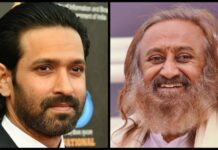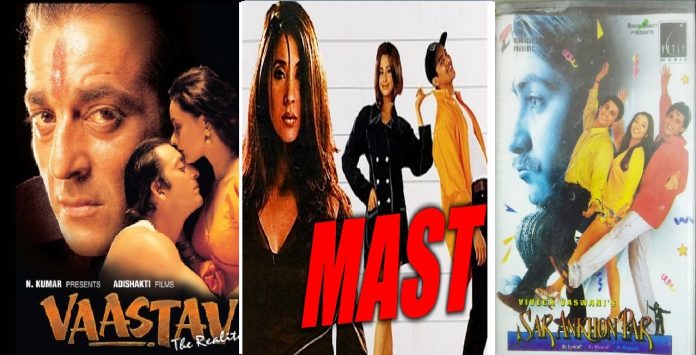VAASTAV
Adishakti Films P. Ltd.’s Vaastav (A) is a violent film that delves deep into the underworld. It shows how an ordinary boy, living in a chawl, can be sucked into the bad underworld even though he never wanted to be a part of it. Once in it, the guy is manipulated by politicians and he ultimately becomes a pawn in their hands. The good-at-heart guy realises when it is too late that even if he wants to, he cannot now come out of the underworld as it is a one-way street.
The film has a story of the kind one has seen on several occasions in the past. But its presentation is what saves it from becoming a routine fare. The juxtapositioning of action and emotions makes the violent drama more humane. But the screenplay has its drawbacks so that the film drops at several places. In a way, it picks up, drops, picks up again, drops again, and this goes on till the end. The best part of the drama is the first part of the first half. The portion just before interval is also good. The second half gets tedious and also meanders at times. For example, the viewer fails to understand the justification for the hero killing the Parsi man despite no orders (from the politician) to that effect. The killing makes the hero such a terrible villain that the audience doesn’t sympathise with him thereafter and even tends to forget that he was a victim of circumstances. The guy’s boastful revelation of his deeds and lifestyle to his parents on Diwali day also looks quite awkward. On the other hand, the scene after the hero’s first killing is brilliant. So are some emotional and action sequences. The climax reminds of Mother India but lacks in impact. Dialogues (Imteyaz Hussein) are very good at several places.
Sanjay Dutt does an excellent job as the guy gone astray. He is as superb as the good-for-nothing lad in the initial reels as the dreaded man of the underworld in the latter ones. Namrata Shirodkar gets very limited scope and gives a fair performance. Shivaji Satam shines as Sanjay Dutt’s father. Reema, as Sanjay’s mother, also delivers a praiseworthy performance. Mohnish Bahl is wonderfully natural. Sanjay Narvekar, as Dedh Phutiya, is mind-blowing. Here’s a guy who is talent personified! Mohan Joshi is able. Paresh Rawal is likeably restrained. Ashish Vidyarthi gets less scope but does well. Deepak Tijori leaves a mark. Usha Nadkarni is excellent. Ektaa, Himani Shivpuri, Jack Gaud, Achyut Potdar, Sunil Shende, Ganesh Yadav, Kishore Nandlaskar and Kashmira Shah (in a special appearance) lend average support.
Mahesh Manjrekar’s direction shows sparks of brilliance. His giving the film a Maharashtrian flavour will, however, limit its prospects to Maharashtra mainly. His writing (story-screenplay) could have been better. Jatin Lalit’s music is average. Raam Shetty’s action has a terrorising effect, and some of the action scenes are truly excellent. Camerawork is good. Other technical aspects are of standard.
On the whole, Vaastav will score very well in Bombay and Maharashtra. In the other circuits, its business should range from average to commission on the strength of action.
Released on 15-10-’99 at Maratha Mandir and 19 other cinemas of Bombay by Jyoti Films Combine thru Shringar Films. Publicity & opening: very good. …….Also released all over. Opening was so-so in Bengal, C.P. Berar (M.P. belt) and Rajasthan.
MAST
Varma Corporation Ltd.’s Mast is the story of a young man who is a crazy fan of a female superstar of Hindi films. He is obsessed with her and cannot think beyond her. On being chided about his madness, the guy, in disgust, leaves his Pune home and comes to Bombay to meet his dream girl. He does meet her but in a situation he would never have dreamt of. Circumstances force the two to run away from Bombay. They come to the guy’s house in Pune and there, their romance begins and blossoms. The guy has a college girl friend who is in love with him. Misunderstandings crop up but they are resolved in the end.
The film has an unusual story which is also unreal. There is so much fantasising by the hero that the audience finds if difficult to identify with him. Yet another major drawback of the drama is the showing of the heroine as a helpless soul. In the public minds, screen Gods and Goddesses are all-powerful but in the film, this myth is sought to be broken. Since not much thought has gone into it, the helplessness of the heroine appears to be totally fake and, therefore, does not create the desired impact. The climax, too, is unconvincing. Emotions do not strike any chord in the heart.
The first half has too many songs in imagination, coming one after another in quick succession. Although they are visually brilliant, they may irritate the viewer because they are mostly in imagination.
In short, an unusual story has been burdened with a defective screenplay (both have been written by Ramesh Khatkar and Vinod Ranganath). The dialogues, however, are very witty and entertaining.
Also on the positive side, the film has several comic and cute moments. Of course, like the rest of the film, even the comedy is of the kind which will appeal to the elite audience in cities. Further, the Ruki ruki si zindagi number and the title song (male and female versions) are excellently tuned (Sandeep Chowta). The film’s look is stylish in song picturisations.
Urmila Matondkar looks very pretty and plays the superstar with complete conviction. She delivers a praiseworthy performance but, nevertheless, falters in the emotional scene in the climax. Aftab makes an exciting debut as the star-crazy guy from Pune. He looks handsome and cute, has a good screen presence, acts with a rare confidence and dances gracefully. Aftab should be a welcome addition to the short list of talented heroes. Antra Mali, as his college pal, acts freely. Dalip Tahhil is pretty impressive. Sheetal Suvarna plays Aftab’s sister ably. Govind Namdev is alright. Snehal Dabi is simply fantastic as the autorickshaw driver. Neeraj Vora leaves a mark. Nitin Raikwar, Vijay Maurya, Rajpal Yadav, Teddy Maurya, Tapan Bhatt and Kuldeep Kaur lend admirable support. Raju Mawani and Smita Jayakar are quite effective. Suhas Bhalekar, Janardhan Parab and the rest provide average support.
Ram Gopal Varma’s direction is good but his reliance on so much fantasy is rather incomprehensible. Besides, the emotional appeal in the drama is found wanting. Songs, as mentioned above, are very well-tuned but a couple of them have not yet become popular. The Na Govinda number can be reduced in length and the Hey Rama song can be chopped off almost totally. The picturisation of Ruki ruki (Farah Khan) is extraordinary. Locations and sets, on which the other songs have been shot, are also breathtaking and so are the picturisations (Farah Khan and Howard Rosemeyer). Piyush Shah’s cinematography is superb. Action is functional. Background score is effective. Technically, very good.
On the whole, Mast has some appeal for the youngsters among the class audience and will, therefore, do well only in selected cinemas of some ‘A’ class centres, mainly of Bombay, Maharashtra and South. In the other circuits, it stands dim chances, more so because its opening is dull. A pick-up in West Bengal (due to Puja holidays) is not ruled out.
Released on 15-10-’99 at Eros and 16 others cinemas of Bombay thru V.I.P. Enterprises. Publicity: extraordinary. Opening: so-so. …….Also released all over. Opening was poor at most of the places.
SAR ANKHON PAR
Pinnacle Entertainments Pvt. Ltd.’s Sar Ankhon Par is the story of a film actor. His son from childhood develops an aversion towards the film industry because of the callousness shown by the industry people when his mother — a stunt artiste — loses her life while performing a dare-devil act for a film. The child grows up nursing hatred for the film industry and its people. A girl comes into his life and the two of them fall in love with each other. But when he gets to know that his beloved is an upcoming film actress, being promoted by his father, he leaves both of them. His animosity towards the industry comes to an end when he sees the warmer side of the industry people at the time of his father’s death.
Although the drama establishes that the film industry is like one big family, it does not negate the stone-heartedness/callousness of the makers of the film on the sets of which the female stunt artiste had been killed. The screenplay (Sanjay Chhel and Viveck Vaswani) is too poor to be true and completely fails to hold audience interest. Some dialogues (Sanjay Chhel and Sunjiv Puri) are about the only good thing in the film. But in its entirety, the drama fails to touch the heart and looks like a forced attempt to make people cry. The computer-generated image of Raj Kapoor in conversation towards the end is quite good.
Dilip Joshi does well. The role, however, needed a well-known actor. Mukul Dev is so-so. Ayesha Julka is quite impressive. Anuj makes a dull debut. Anoushka shows promise in her performance. Hiralal Thakkar, as the studio watchman, impresses a great deal. His emotional dialogues in the climax are well-written and equally well-delivered. Keith Stevenson, Nivedita Joshi, Dayashankar Pandey, Sharad Smart, Charlie, Harpal, Shashi Sahay, Helen Brodie and Sahitya Sethu are so-so. There are several guest artistes and they don’t even manage to lend face value to the film.
Except for one or two emotional scenes handled ably by debut-making director Gyan Sahay, the film otherwise is an aimless exercise which can be dismissed off as a totally unimpressive and lacklustre fare. Sahay’s camerawork is good. A couple of songs are fairly well-tuned. Picturisation of the birthday song is good. Technically, okay.
On the whole, Sar Ankhon Par is a sick drama with no chance of survival at the ticket windows.
Released on 15-10-’99 at Gemini and 1 more cinema of Bombay by Pinnacle Entertainments P. Ltd. thru R.G. International. Publicity: good. Opening: fair. …….Also released in C.P. Berar and Mysore.
‘SARFAROSH’ SILVER JUBILEE
Cinematt Pictures’ Sarfarosh, with which ad filmmaker John Mathew Matthan made his debut as writer-producer and director of a feature film, has celebrated silver jubilee this week at Maratha Mandir (matinee), Bombay and in other territories. The film stars Aamir Khan, Naseeruddin Shah, Sonali Bendre, Mukesh Rishi, Akash Khurana, Sukanya Kulkarni and Akhilendra Mishra with Govind Namdev in a special appearance. Dialogues: Hriday Lani and Pathik Vats. Cinematography: Vikas Sivaraman.
HC ASKS YASH RAJ FILMS TO RELEASE ‘DDLJ’ NEGATIVE FOR OVERSEAS PRINTS
Justice A.P. Shah of the Bombay high court, in an ad interim order issued recently, has directed Yash Raj Films, Bombay, to make available the negative of Dilwale Dulhania Le Jayenge to the laboratory for making new prints for use by the Overseas distributors, Rishima International Pvt. Ltd. Rishima International claimed that Yash Raj Films had a contractual obligation to do so.
Earlier, Rishima International had complained to the Indian Film Exporters Association, which had arbitrated in favour of Rishima. Alleging that despite the arbitration award, Yash Raj Films continued to default on the matter, Rishima International moved the court.
AKSHAY KUMAR BEREAVED
Brij Mohan Bhatia, father of Akshay Kumar, expired on the evening of 13th October at his Lokhandwala residence in Bombay. He had been suffering from cancer. He was cremated the same day at Amboli crematorium. He is survived by his wife, a son and a daughter.
Chautha was held on 15th October at Khar, Bombay.
TELECAST OF ‘KKHH’ ON SONY TV STAYED
The civil judge (sr. division) no. 1, Guwahati, granted an ad interim injunction vide order dated 12th October on the telecast of Dharma Productions’ Kuch Kuch Hota Hai. The order was passed on a motion made by the film’s Assam distributors, Azaan Films, Guwahati. According to Azaan Films, Kuch Kuch Hota Hai was acquired by it from producer Yash Johar on an outright lease of 5 years for Assam territory. The producers had also given it an undertaking that the film will not be exploited by them (the producers) in the territory. Construing the impending telecast of KKHH on Sony TV as, inter alia, “exploitation in the Assam territory”, Azaan Films moved the court and succeeded in obtaining a stay against the telecast.
SHAKTI SAMANTA REPLACES SHOREY AS IMPPA CHIEF
Following the no-confidence motion against IMPPA president K.D. Shorey last week, the executive committee of the IMPPA met on 10th October at the IMPPA House and elected a new president in place of Shorey. Shakti Samanta was elected to head the association for 1999-2000.
Shorey, it may be recalled, had been elected IMPPA president on 26th September but was voted out due to lack of confidence in his presidentship within a fortnight.
DO YOU KNOW?
* Sunny Deol’s debut directorial venture, DILLAGI, is oven-hot in East Punjab. The distributors of the double Deol starrer have paid a crazy price for its rights because it is a well-known fact that Punjab is the stronghold of the Deols. The story doesn’t end here. Having acquired DILLAGI at an astronomical price, the distributors have succeeded in getting absolutely fantastic terms from exhibitors of East Punjab. Cause for Sunny Deol and Bobby Deol to celebrate, right?
* The distributor, who has acquired Rajshri’s HUM SAATH-SAATH HAIN for Mauritius, was so moved after seeing the film that he told a friend, “You feel like becoming a better human being after seeing the film.”
* D. Rama Naidu, who had promised Anil Kapoor a Mercedes Benz if his Anil starrer, HUM AAPKE DIL MEIN REHTE HAIN, would prove a success, has kept his word. He will be getting the actor the car very shortly. He made this known to brother Boney Kapoor on 15th October, the day Naidu launched his new film, AAGHAAZ.
PRODUCTION NEWS
‘Badal’ In Switzerland
The unit of Aftab Music Industries’ Badal left for Switzerland on Oct. 13. to picturise two songs on Bobby Deol and Rani Mukerji. The film is being directed by Raj Kanwar. Also in the cast are Kulbhushan Kharbanda, Ashish Vidyarthi, Shahbaaz Khan, Vishwajeet Pradhan, Mayuri Kango, Neena Kulkarni, Harish Patel, Razzak Khan, Dinesh Anand, Upasna Singh, Johny Lever, Mushtaq Khan, Ashutosh Rana and Amrish Puri. Screenplay: Robin Bhatt and Sutanu Gupta. Dialogues: Santosh Saroj. Dances: Chinni Prakash and B.H. Tharun Kumar. Action: Bhiku Verma. Masuda H.M. Ishaque presents the film which is scheduled for release on Jan. 7, 2000 all over.
ANNOUNCEMENT & LAUNCHING
Bobby-Urmila Starrer ‘Aashiq’ Launched
Shweta International’s Aashiq was launched on Oct. 11 with the recording of a song at Empire Audio Centre. Penned by Sameer, the song was set to tune by Sanjeev-Darshan. The duo recorded two more songs after that. Many notables of the film industry attended the recordings. Bobby Deol and Urmila Matondkar play the romantic lead in the film being produced by Anil Sharma and directed by K. Murali Mohan Rao. Writer: Anwar Khan.
Rama Naidu Launches ‘Aaghaaz’
Producer D. Rama Naidu launched Suresh Productions’ Aaghaaz (The Beginning) with the recording of two songs on Oct. 15 at Sahara India. The recordings will go on till Oct. 18. The songs, penned by Sameer, are being composed by Anu Malik. Both of them are duets being rendered by Sonu Nigam and Sunidhi Chauhan; and Alka Yagnik and Babul Supriyo. The film, a remake of the Telugu hit, Sivaiah, is being directed by Yogesh Ishwar. It stars Sunil Shetty, Sushmita Sen and one more heroine to be finalised. In the supporting cast are Sharad Kapoor, Govind Namdev, Sharat Saxena, Saadhika, Shraddha Nigam, Mukesh Tiwari, Anjan Shrivastava, Alok Nath, Dina Pathak, Anupam Kher and Johny Lever. Screenplay: Nikhil Saini. Dialogues: Kamlesh Pandey. Art: Sharmishtha Roy. Regular shooting will begin in November.
3-E
Education-Entertainment-Enlightenment
Filmi Week
Few films based on the film industry get made because the industry isn’t really a very nice subject for filmmaking. Considering this fact, isn’t it surprising that two of this week’s releases have the film industry as its base. Urmila Matondkar, the heroine of Mast, plays a glamorous and successful film star in the film. In Sar Ankhon Par, Dilip Joshi plays a character artiste who is the film’s central character. In fact, the entire film is about the film industry.
For Your Eyes….
Information had the occasion to see two songs of Rajshri’s Hum Saath-Saath Hain. Mhare hivda mein naache mor has the makings of a hit number. The song will climb the popularity charts and reach the no. one position soon. The picturisation, too, is truly exciting to complement the wonderful music. The other song one saw was the Bhagwan number. This one is bound to have the public reach out for their handkerchieves from their pockets/purses. It’s such an emotional number that even if you hold back your tears all through the song, you will give in towards the end. That’s when Neelam — she plays the sister of Mohnish Bahl, Salman Khan and Saif Ali Khan — leans against her mother (Reema) and breaks down. The lyrics stop for a moment, the music also stops. It is just the sound of Neelam crying — and this in a celebration party amidst hundreds of guests and family members. The ladies, and the men, too, in the auditorium, will find tears rolling down their cheeks at this point. Some, of course, may not cry. Because they will sob.
‘Mr. India’ Proteges
Three of the many kids, who featured in Boney Kapoor’s Mr. India, directed by Shekhar Kapur, have grown up and may be on the way to becoming big names. While Ahmed Khan has already turned an established choreographer, Aftab Shivdasani makes his debut as hero in Ram Gopal Varma’s Mast, released this week. And Karan Nath (son of producer and star-secretary Rikku) is being introduced as lead man by Kuku Kohli in his next, to be launched shortly.
Even Shekhar Kapur’s directorial assistants have turned directors, like Satish Kaushik (who was his chief assistant), Raj Kanwar, and Sanjay Khanna (who directed Shastra). Shekhar also had two female assistants. One of them, Farzana, is secretary to Rekha, and the other, Mona Ambegaonkar, became an actress (Baharon Ke Manzil) and is these days seen on television.
As for Shekhar Kapur, he’s gone international. Mr. International, the visible version!
An Offbeat Upendra
And now some light on Kannada films. The two Kannada films, which have proved super-hits in recent times, are Om and A, both scripted and directed by Upendra, who is considered an iconoclast for his deep-rooted belief in making offbeat films. Upendra has now directed as well as acted in a film titled Upendra. The film was released this week (on 14th October) in Bangalore. It ends with a note from the director: “I know, you have not understood this film. To understand it, you will have to see it again”! The film is based on the thought that we are all bad from within but we hide the bad streak in ourselves with our outward appearances. For example, we can consider a priest (pandit) to be a pious man. But he, too, is bad in some way. The director exemplifies his thought through a scene in which Upendra forces a pandit to drink alcohol. The pandit drinks much against his wishes. But the next day, the pandit is shown enjoying a drink and saying to himself that he has never enjoyed so much in life!
The film opened to a bumper response. A compliment indeed to the director’s genius!
Whither Khans!
What is the box-office value of the Khans? Ask Mysore distributor Pal Chandani of Pal Enterprises, Bangalore. He has released Mann, Baadshah and Hello Brother. While Mann just about proved a commission earner, Baadshah is just average, and Hello Brother, a heavy loser. Besides these, he released Hogi Pyar Ki Jeet and Haseena Maan Jaayegi, both of which are losers in Mysore. Only Taal and Sarfarosh, released by him this year, are overflow fares.
Sar-Spinning Experience!
Sar Ankhon Par, a film which gives a glimpse of the Bombay film industry through the story of a film actor, proved a head-spinning experience for its Bombay, C.P. Berar and Mysore distributors. At Vijay, Nasik, the 12 noon show on the opening day had to be cancelled for want of audience. The 3 p.m. show also had to be cancelled for the same reason. The film had, obviously, to be discontinued after this. At Chitra, Amravati, the first show could record only Rs. 434! In Bangalore, the Symphony cinema presented a simply pathetic sight as there were only six people for the first show on the first day! It goes without saying that the show was cancelled. The only cinemas which were house-full in their first shows were Bombay’s Gemini (Bandra), which has 238 seats, and Sona (Kandivli), which has 304 seats! And no prizes for guessing why they were house-full.
Quiz Time
A query for those keeping a close watch on the box-office collections in Bombay city and suburbs: Which first-run film recorded the highest percentage in the week that went by? And in which week was that film running?
Is it from any of the following?
Dil Kya Kare (3rd week 48.53%); Hello Brother (5th week 47.26%); The Mummy (dubbed) (2nd week 46.45%); Taal (9th week 45.78%); Hum Dil De Chuke Sanam (17th week 41.52%); Hum Tum Pe Marte Hain (3rd week 40%); Sanyasi Mera Naam (2nd week 35.35%); Kuch Kuch Hota Hai (52nd week 32.12%); 1947 Earth (5th week 31.46%); Baadshah (7th week 30.84%); Kohram (9th week 20.45%).
None of the above! Aditya Chopra’s Dilwale Dulhania Le Jayenge (tax-free) recorded the highest percentage – 64.49% in its 204th week at Maratha Mandir (matinee). …….The only film to score above DDLJ was Ramesh Sippy’s Sholay, which, in its umpteenth repeat-run, scored 71.95% at Moti.
INFORMATION MEETS
“The story of a film is like an empty bottle in which the soul of the filmmaker is poured. Thus the film has its maker’s touch, his views, his ideology and, above all, his vision of the world and the kind of world he wants.”
– VIJAY ANAND
RAJ VAIDYA
“Mujhe maar-maar kar filmmaker banaaya gaya tha.” Coming from one of the finest directors India has ever produced, the statement comes as a revelation. But then, that’s Vijay Anand for you. A chat with him is full of pleasant revelations. For example, in spite of achievements, here is one man who has absolutely no time for posterity. He hardly mentions his films unless it is to illustrate a point he is making. Anyway, coming back to being forced into filmmaking, he adds, “I never wanted to have anything to do with films. In fact, I wouldn’t have been in this field had my brothers not needed me.” Reason enough for us to thank Dev Anand and late Chetan Anand for not letting his filmmaking talent go waste.
At 19, Vijay Anand had already notched up his first success by scripting brother Dev-starrer Taxi Driver. In the next few years, he sailed into direction as well and charted for himself an enviable graph of box-office successes. In the process, he also won unequivocal critical acclaim for his works. Be it Teesri Manzil, Guide, Tere Mere Sapne or Johny Mera Naam, Vijay Anand has proved his calibre in various genres. At the peak of his career, the spiritually-inclined Vijay Anand chucked everything to go into “serious thinking” and attempt to find inner peace. Was it a tough decision to quit a successful career, we enquire. He replies, “Not in the least bit. I simply left something that was less important for something that was more important.”
In the eighties, he staged a comeback with Ram Balram and Rajput. Then followed a 15-year-long self-imposed hiatus from filmmaking, which finally ended a couple of years back when brother Dev Anand asked him to make a film with him once again. That is how Jaana Na Dil Se Door happened. It is really a reflection of our times that the very man whose films used to be closed on the day of the announcement itself, has to struggle to sell his film today even as the film is nearly complete.
ON FILMMAKING
“A good filmmaker puts his soul into the film. A great artiste immerses himself completely in his creation. He is there in totality. The way he looks at the world comes through in what he creates. The story of a film is like an empty bottle in which the soul of the filmmaker is poured. Thus the film has its maker’s touch, his views, his ideology and, above all, his vision of the world and the kind of world he wants. He presents this world to people when they are enclosed in a theatre, completely detached from their world outside. For the next few hours, they live in this world which is imagined, created and fulfilled by the filmmaker.
“There are two kinds of films you can make. You can make a film that gives you inner satisfaction, a film in which you conquer your own ground. If you want to conquer the medium — say, you want to be a master of writing, or of screenplay, or lyrics, or art direction, or direction and so on — then, you need to learn all this. But there are no teachers around. So, you gain experience and become your own teacher. And in doing so, you begin to struggle with yourself. At the end of the struggle, however, you are rewarded by feeling complete satisfaction over what you have created. You can then say, I’ve got the shot that I wanted, or got the music and lyrics that I wanted, and so on. This feeling of internal success is the most satisfying thing in the world.
“Then, there is the second kind of success, which has become the biggest success today. This comes from what others think of your film. Today, if a hundred people say, your film is good, it is good. But if one person says, it’s good, it is not. This is probably the democratic way of judging a film! According to me, such an assessment is aesthetically wrong. Good things always take a while before people can begin to appreciate them. A Gandhi has to die to become immortal. It was only after Guru Dutt died that people realised that he was an art filmmaker also.”
ON HIS OWN STRUGGLE
“My whole aim in life has been to struggle with myself. I have striven to gain more and more ground — more and more mastery over my medium — throughout my life. I conquered new ground with every film that I made. Yes, I haven’t made a single film in the last 15 years, which means, I have also lost a lot of ground. This I will have to cover with the help of a lot of other things that I haven’t yet mastered. For example, I will promote myself. Once, I never cared two hoots for it. But today, I realise the importace of promotion and publicity. Earlier, I often used to wonder why makers of the calibre of Bimal Roy or Satyajit Ray had to promote themselves and their films. Now, I realise that they were so right in doing what they did. After all, if you do not promote yourself, who else will? How will people come to know that I have a product that I want them to come and see?”
ON ‘JAANA NA DIL SE DOOR’
“It was Dev saab’s idea to make another film together. I too wanted to make a film for him, and that’s how it all started. On my part, I did not want to give Dev saab a role which he has played all his life. I also didn’t want to give him a role that he has played with me plenty of times. So, I thought for a long time and finally created a role which keeps his aura alive, yet is different from what people expect from him. When you see the film, you’ll say, ‘this is the continuation of Dev Anand, but is not Dev Anand.’
“Jaana Na Dil Se Door is the story of a man who has been separated from his wife and daughter. He has terribly wronged his wife. He is a great artiste and, like many great artistes, he thinks that he is so great that it is okay for him to neglect his personal life. Don’t they say, ‘Great artistes make lousy husbands’? This man’s ego has made him lose his wife and daughter. He doesn’t remarry because he still loves her. But one fine day, his daughter comes back and he is forced to rethink his life through her eyes. For the first time, he questions his past actions and realises that he had been so wrong to his wife.”
ON DIRECTION
“I do not see writing as a different function from direction if you are a writter-director. Similarly, editing is not a third separate function, but the continuation of the first. The entire range from conception to writing to enacting to filming to editing and recording is an extension of a single thought process.”
ON THE UNPREDICTABLE NATURE OF FILM BUSINESS
“Aaj hamaare paas ginti ke paanch playback singers hain, ginti ke paanch music directors hain, aur 12-13 stars hain! I feel, every year, at least a dozen new stars should arrive on the scene. But that doesn’t happen because of the star system which allows them to take on as many as 12-13 films at a time. Ideally, a star should not work in more than two or three films at a time. But that doesn’t happen. What is worse is that you cannot blame them. They say, it is the producers’ fault. Producers simply pass the buck to the distributors, who, in turn, blame the exhibitors. Aur exhibitor kya karta hai? Woh poora ka poora blame audience par daal deta hai! But, who can predict how the audience will react to a particular film or its star? So, ultimately, the whole scenario revolves around guesswork. What I am trying to stress is that every film that has done well so far has done so in spite of this shortcoming.
“Let me give you an example. Nasir Husain had to hold more than 50 trial shows of Qayamat Se Qayamat Tak in the hope that someone would buy the film. Everyone was saying that the film had no hope as everyone connected with the film — from its lead pair, to director to music director — was new. They said, even the title of the film is so strange. The producers waited months for distributors to appear, but the only people who came were brokers. Now tell me, who could have guessed at that time that the film will do so well at the box-office, and that every person concerned with the film would go on to become a star! Even my Kora Kagaz had not inspired enough confidence in the trade prior to its release. The film’s producer nervously came to me and said, ‘The film is not getting sold. You must re-edit the film, or do something so that I’ll be able to sell it.’ Just one song from that film became such a huge hit that it carried the entire film on its own.”
ON AUDIENCE
“The bottom line is that our audience are not foolish. When you have managed to bring people into the cinema hall, they are willing to cast aside all their notions, provided the film grips them. Audience enter the cinema hall with a lot of pre-conceived notions, which should be destroyed in the very first reel of the film. The film that succeeds in doing so also succeeds in making the audience believe in the ideas propagated in it. There is a certain claim that a film makes, when it starts. That claim — whatever it be — must be fulfilled before it ends. When the film ends, the audience must feel that they have seen something new. They should feel that the way they look at themselves or at others, has been changed in some way. They should feel that they have experienced something beautiful, and so on. There is absolutely no way a film can fail, if it achieves any of these things.”
ON THE PRESENT STATE OF THE FILM INDUSTRY
“Our biggest problem is that we failed to become an industry in the true sense of the word. Hollywood became what it did because they very successfully integrated the three main areas of film business — production, distribution and exhibition. An MGM film will always be screened at Metro cinema. In India, Rajshris are successful because of this very reason. Otherwise, it is so ridiculous to have to go and plead with others to buy a film produced by you. You have to go and tell the buyers, ‘I have made a nice film. At least, see it. Buy it.’ And who is this buyer? He is a man who never goes by his own judgement. He will go to 10 people who have seen your film, and only if he gets a majority vote in its favour will he buy the film. He doesn’t employ his judgement at all. His solitary aim is to con the theatre owner, who is another man with a mind of his own. This man will say, ‘Govinda’s film did well last time, so give me a Govinda starrer. Don’t give me Akshaye Khanna because no one wants to see him! I want to ask him, how does he know for sure if tomorrow Akshaye Khanna won’t be the biggest star? It has happened before. Amitabh Bachchan gave a string of flops early in his career. Several of his films were shelved after a while. People started criticising his height. Then came Zanjeer and everything changed. Suddenly, all his shelved films began to be revived and a hundred more films were made with him later and he was pronounced the star of the millennium. The point is, who can write destiny? This is the reason why I say, everyone must be given an opportunity.
“The irony is, all these middlemen are conditioned to think in the manner they do and can’t break free. And unless they break free, vey hamesha beech mein gadbad karte rahenge.
“Our film industry will become an industry in the true sense of the word only if we get the exhibition sector in our hands. But that does not seem to be happening.
“The government is the biggest factor that could make a difference. But all it seems interested in is filling its coffers. The attitude is simply to find newer ways to tax film trade without bothering to make any contribution to its growth. I say, there should be a payback on the money the government earns from us. Once, I had suggested that levy whatever tax you want to, provided you create a fund for the film industry. Lend producers money out of this fund, to make films and even charge an interest on the amount. The idea was to help producers to avoid having to approach the underworld for finance. Sadly, this proposal did not receive any backing from the industry.”
ON THE SO-CALLED INDUSTRY LEADERS
“Our leaders never make a thorough proposal about anything before they approach the government. All that they do is serve their own purpose and return. If they had learnt to lobby for our demands, the government would not have continued to ignore us for so long. Our industry has grown so much today. The amount of foreign exchange our films have earned in recent times is phenomenal. There is a vast potential for improvement but, for that to happen, the industry and the government have to come together as equal partners. To do all this, we need to have a strong will and unity, which we sorely lack.”





























